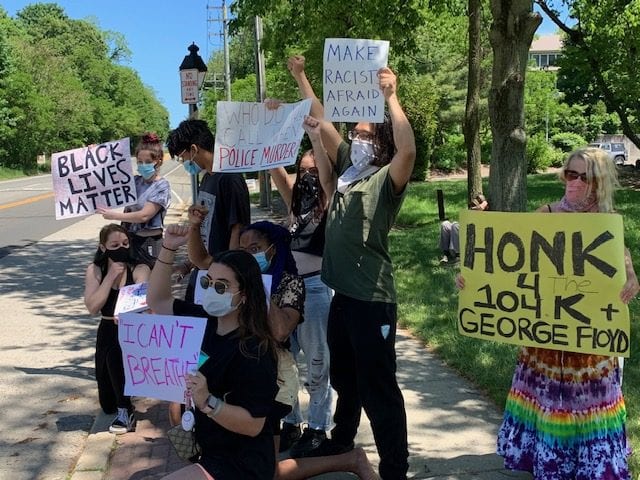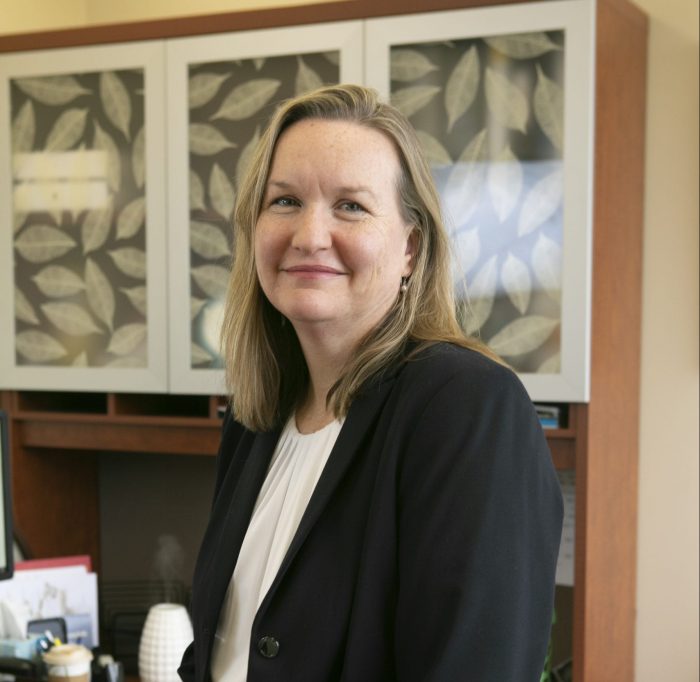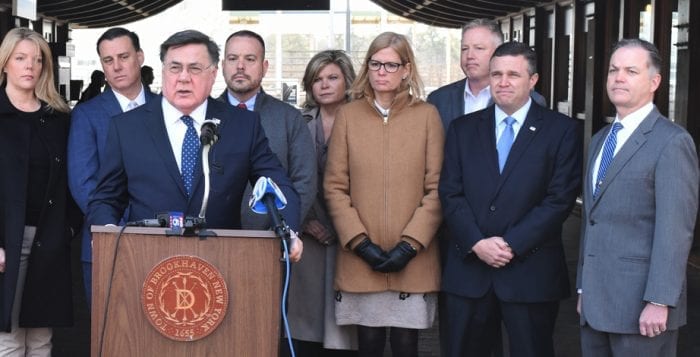Residents in Commack and East Northport were treated to a rolling car show Oct. 11. The show was the eighth one that took place this year and the last for 2020. Smithtown resident Patty Mancuso organized the events and started the Facebook page Smithtown Rolling Car show. “I started this because there were no car shows this spring, something me and my husband Phil really look forward to,” she said. “As I watched one SUV birthday parade after another pass my house while working from home, I dreamed of something better to watch.” Mancuso said after choosing what neighborhood to drive through, she would map out the route and contact residents through the Nextdoor app. During the last few months, the rolling car show has been spotted in Smithtown, Hauppauge, Dix Hills, Commack, East Northport and Kings Park. Photos by Jennifer Castillo
Suffolk Officials “Grateful” for Peaceful Demonstrations

Amid the confluence of social unrest caused by people eager to see the economy reopen faster and those distressed by the killing of Minneapolis resident George Floyd, County Executive Steve Bellone (D) said he appreciates the peaceful way people are demonstrating in Suffolk County.
“I want to thank everyone who has been out there, participating in these demonstrations, for doing this peacefully, and expressing their rights as American citizens,” Bellone said on his daily conference call. “Unfortunately, we have seen too many instance where that has not been the case across the country.”
Indeed, in several cities, the reaction to the death of Floyd after a former police officer knelt on his neck for over eight minutes, has led to violence and chaos.
“Looting is never acceptable,” said Bellone. “It undermines the point of the message. It has the effect of taking the attention away from the change people are fighting for, the change people want to see.”
Viral Numbers
The number of people who tested positive for COVID-19 in the last day was 111, bringing the total to 39,643. That doesn’t include the 13,953 who tested positive for the antibody.
As fo May 29, the number of residents in the hospital with COVID-19 declined by six to 269.
The number of people in Intensive Care Unit beds also declined by six to 74.
Over the last day, 24 people were discharged from the hospital.
The number of fatalities related to complications from the virus continues to climb, with nine people losing their lives to the pandemic, raising the total to 1,901.
The county distributed over 9,000 pieces of personal protective equipment in the last day, raising that total to over 5.7 million.
Three Candidates Vie for Two Seats in the Commack School District
Commack School District Board of Education has two seats up for grabs with incumbent Susan Hermer and Mike Weisberg running for one position. As for the second seat, incumbent William Hender is running unopposed.
Voting will be done through ballots mailed to residents, due to the COVID-19 pandemic, and are due back to the district by June 9.
Susan Hermer

Last year, Hermer beat out Jennifer Scully for a one-year term after the resignation of former board member Jennifer Carpenter.
The attorney, with a general practice firm in Bohemia, said being on the board has been fulfilling for her.
“I am running for my first full term because I enjoy being on the board advocating for our students and teachers,” she said. “And all members of this board get along and respect each other. I love our kids and the school district, and I relish being back in the schools since I no longer have kids in the district.”
She said she is concerned that some programs may need to be cut from the budget due to the reduction in state aid.
“I also want to make sure our special-needs students get all the help they need,” she said. “I am happy with the lease we worked out with Long Island University and the Marion Carll property, and I am pleased with the capital projects bond we recently passed.”
Last year the district worked out a deal with LIU for the educational institution to use the Marion Carll Farm, which was left to the district decades ago and fell into disrepair as it became difficult to keep up with the expenses to maintain the property.
Mike Weisberg

A lifelong resident of Commack and school psychologist in a neighboring district, Weisberg said he believes his professional experience, as well as being a parent and working in a school district, will be an asset to the trustee position.
He said with the stress and uncertainty of the COVID-19 pandemic, he feels there will be an increased need to support students socially and emotionally. He added he believes there will be more issues regarding the negative effects of an overdigitalized world.
“Now we’re dealing with a global crisis, with an emphasis on social learning,” he said. “I really believe even before we got into this pandemic, we were seeing an increased need in dealing with this overdigitalization.”
Weisberg had originally planned to run last year, and said he postponed his candidacy to become more involved in committee work in the district. He said his main concerns are maintaining the programs and the number of classes currently offered in the district.
“Commack has done a great job of providing a lot of that,” he said. “I would really like to do whatever we can to maintain that diversity, because educating a student is much more than teaching math equations or learning a specific skill. It’s really about helping children to develop into their full potential as adults, and schools really play a vital role in that.”
William Hender

This will be the second term on the board for Hender. He said he brings an “important and necessary skill set to the position.”
“Having spent the past 20 years in education, as a teacher and administrator, I have a good understanding of what is necessary to continue to provide access and opportunity for all our students,” he said. “I think we have developed a great team here in Commack and I am happy to be part of it. I am a product of the Commack School system and attribute many of my successes to the education that I received. I want all students, including my own children, to have the same wonderful experiences for years to come.”
Before the COVID-19 pandemic, Hender said he had no concerns regarding the budget. “However, now I have many concerns, such as will the governor continue to make cuts to school aid throughout the year, and if so, how much?” he said. “In addition, I am concerned about what changes in programs and cuts we will need to make once the actual cut in state aid is announced.”
Smith Point, Cupsogue Beaches Open for Memorial Day Weekend
Even before Suffolk County officially clears all the hurdles for a phased economic reopening, the county is planning to open Smith Point and Cuspsogue beaches over Memorial Day weekend.
County Executive Steve Bellone (D) suggested that keeping children home during the holiday weekend and the unofficial start to summer would be unrealistic, especially after all the limits placed on them to contain the spread of COVID-19.
While the beaches would be open, the visit to some of Long Island’s more inviting summer destinations won’t be the same as it is in any other year, as physical games, such as football and basketball, are limited.
Guests who visit the beaches will need to wear masks when they can’t maintain social distancing with other families or groups visiting the beach.
The bathrooms will be open and will have hand sanitizer. Attendants will also monitor the restrooms to ensure they remain sanitized.
Residents “won’t be playing contact sports,” Bellone said on his daily conference call with reporters, but they can go in the water.
It’s in the wake of more bad news for Long Islanders hoping Suffolk would be able to clear the hurdles necessary to open in a short time frame. Friday, Gov. Andrew Cuomo (D) extended the New York Pause stay-at-home order until May 28, excluding the five of 10 upstate regions already set to start the reopening process.
Downstate, including Nassau and Suffolk Counties, have not met the seven criteria in order to open. Long Island is being counted as one region for the purposes of reopening, and New York State’s dashboard shows LI has still only met four of seven criteria. Long Island still requires a 14-day decline in hospital deaths, a supreme decrease in new hospitalizations and hundreds of new contact tracers.
As for the update on figures for the county, Bellone reported 175 new positive tests for the virus, bringing the total, without antibody tests, to 37,719.
Through Wednesday, the most recent period for which Bellone has data, the number of hospitalizations fell 21 to 554 which is “still a high number,” albeit one the county hasn’t seen for six or seven weeks.
The number of people in Intensive Care Unit beds increased by two to 185.
The county was below the 70 percent target for bed capacity, with 69% of hospital beds and 65% of ICU beds in use with patients who are battling COVID-19.
In the last day, 44 more people returned home from the hospital to continue their recoveries.
The number of people who have died from the virus increased by 12, bringing the total to 1,709.
SB Launches HealthierU, Provides Mental Health Support

Stony Brook University has taken numerous steps to protect the mental and physical health of the many health care and hospital workers who are helping the growing number of people suffering through the coronavirus pandemic.
Indeed, this past Monday, the university launched HealthierU, an employee wellness program, which streams 30-minute sessions Monday through Friday at 3 p.m.
“A lot of us are thinking about staff on the hospital side who are really being tested in an unprecedented way,” said Cathrine Duffy, the director of HealthierU. “I feel especially humbled and moved to be able to help in any small way given their vast efforts.”
The sessions will cover themes such as feeling connected during social distancing, self-care, our common humanity, worries, anxieties and fears and finding meaning in difficult times.
The sessions are interactive, encouraging viewers to comment, ask questions and give feedback for use in later programs. The focus of the sessions will include guided imagery meditation, drawing and writing, stress reduction and nutrition. The programming will run through at least April 10 and possibly longer. After the live session, the videos will be available on Stony Brook’s HealthierU web site.
The first session had almost 300 views and Stony Brook just posted its second session on the web site. Both are available on Facebook and will be posted to hospital channels.
HealthierU is looking at more long-term topics such as financial wellness and even the possibility of bereavement support.
The audience for this can include members of the community, as the sessions will not be password protected. Those participating in the program can provide commentary, which Duffy will moderate while mental health expert Joshua Hendrickson, who is an integrative mental health and an alumnus of Stony Brook, will facilitate the program.
At this point, Duffy has not reached out to experts to see if they are available or interested in leading future classes, although Stony Brook staff and community members have contacted her about the programming.
Indeed, on Monday, the staff at the Mindful Turtle yoga studio, which was founded and is owned by Danielle Goldstein, offered free streaming zoom yoga to Stony Brook employees for 20 classes each week.
“We are able to offer the classes for free because of the support we have received from the community,” Goldstein wrote in an email. “Students are continuing to pay their memberships which allows me to continue to pay the yoga teachers for the online classes.”
The notion of helping the Stony Brook community originated through group discussions among teachers. The group which includes Stacy Plaske who had run Balance Yoga, which Goldstein now runs, wanted to help healthcare workers. A nursing school student, Plaske reached out to her Stony Brook contacts.
Stony Brook employees can also access a virtual employee assistance program through the web site StonyBrook.Edu/EAP.
Health care workers throughout the country can also access Headspace, a mindfulness and guided meditation app, and 10percenthappier, a meditation app, for free.
Stony Brook started a virtual support group yesterday through Microsoft Teams at 8 a.m., noon, and 8 p.m. every Monday through Friday. These groups are open to anyone at Stony Brook who is part of the health care team.
Stony Brook started a virtual support group specifically for residents, according to Adam Gonzalez, the Director of Behavioral Health at Stony Brook Medicine.
Stony Brook is working on creating an email where employees can write to request individual virtual sessions as well. To request a virtual one on one session, faculty can contact the faculty/ staff care team by phone and/or email.
Another initiative Stony Brook developed is called Not All Superheroes Wear Capes. The community has sent pictures, handmade cards, and video messages that the university shares with its hospital staff. People have sent in pictures as well as children singing “God Bless America” or holding up thank you signs, which are “a great motivator for the doctors and nurses on the front lines,” as well as a show of appreciation and support, said Gonzalez, who has worked on the mental health of first responders to the World Trade Center disaster and responders to Hurricane Sandy. He is also working with NASA on ways to provide mental health care to astronauts during long duration space missions.
People can send these supportive cards and messages to [email protected].
The whole organization is encouraged to download Microsoft teams on their phones and laptops and home computers, according to Gonzalez. Employees can click on the app and click into the wellness channel to see these messages. They can view messages and support resources on the Wellness Champions channel, which is for Stony Brook Medicine employees. They can also access the virtual support groups through the app.
Duffy, who is a 10 percent Employee Assistance Program counselor and is on a group with the Wellness Champions channel, which Gonzalez runs, said the channel is for Stony Brook Medicine employees, who are mainly hospital staff. Stony Brook is sharing links widely through internal channels such as the hospital Pulse page.
Gonzalez suggested the traumatic situation of the pandemic and the quarantine response creates a normal stress reaction. That includes being anxious and hyper vigilant and worried, struggling to sleep, and feeling run down and scared.
Practicing mindfulness, which means being in the present moment, can help people stay grounded, Gonzalez said. Mindfulness can include practicing meditation exercises, paying attention to your breathe, listening to music, connecting to family and friends, or focusing on a pleasant activity like watching a movie.
“Having hope that this isn’t going to last forever” also helps, Gonzalez added.
The Wellness Champions channel has different resources for supporting mental health, including recommendations from the CDC and the World Health Organization, access to free meditation apps, and virtual substance abuse recovery resources like Alcoholics Anonymous and other programs.
Gonzalez works through his own stress by connecting with family through a group text message, using Facetime with his niece and nephew, and calling friends and colleagues.
Duffy expressed her goal to see these efforts contribute to life for those dealing with significant challenges and changes.
“I truly hope this work provides some peace and comfort to everyone working on the frontlines, from health care providers to faculty transitioning courses to online, to staff transitioning their services online, to our IT department keeping us all connected,” Duffy said in an email.
Stony Brook Creates New Coronavirus Triage Site, Adds ICU Safety Protocols
Stony Brook University Hospital has created a new triage process for emergency services.
Patients who arrive at the emergency room between 11 a.m. and 11 p.m. should stay in their cars, where a member of the staff will determine the correct emergency care setting. The staff may tell patients to go to the main Emergency Department or to a new coronavirus triage service at the South P Lot testing facility on the main campus, on the corner of Stony Brook Road and South Drive. The triage area will have board-certified emergency medicine physicians and emergency medicine nurses.
Stony Brook medicine has also created a triage phone line, 631-638-1320. Registered nurses will answer calls from 8 a.m. to midnight, Monday through Friday. Nurses will direct patients to the appropriate healthcare location.
The goal of the triage service, Stony Brook said, is to provide patients with a streamlined environment for care and treatment.
Stony Brook said patients should not go to the coronavirus patient triage unless a member of the Emergency Department staff directs them there.
The main Emergency Department will remain operating as usual.
In addition, Stony Brook has established new safety procedures to reduce the amount of time that a caregiver must enter a room. The process is best suited for the Intensive Care Unit or where a patient is non-ambulatory. Stony Brook is following procedures other hospitals are also using.
IV pumps will now be located in the hall. To reach the patient, the IV pumps will use Relocatable Power Taps, which are power strips approved by Biomedical Engineering, and IV extensions sets.
The new process will eliminate the need for staff to go in the room to change IV fluids, drips or medicines or to reset alarms, which will limit exposure while interacting with people who might have coronavirus or with patients who have tested positive for COVID-19.
The tubing is standard bore and can be used for all fluids including blood.
Three sets of IV extension sets can be connected together to reach patients. IV pumps in use can be located in the hall or anteroom.
The hospital ordered 72-inch IV extension sets and will work by themselves in most cases to reach the patient.
LI Officials Call on MTA to Rescind Planned LIRR Fare Hike

Local and state officials, along with citizen advocates voiced a collective message to the Metropolitan Transportation Authority and New York City during a press conference at Ronkonkoma train station on March 2: “Stop shortchanging Long Island.”
The group called on the MTA to abandon its plan for a systemwide 4 percent fare increase in 2021 for Long Island Rail Road customers, including those in Nassau and Suffolk counties. The decision was a part of the NYC Outer Borough Rail Discount plan which offers an up to 20 percent discount for city riders.
“Everything is being pushed out to Long Island in terms of expenses and it won’t be long until you’re expected to buy them a coffee and a bagel as well.”
— Ed Smyth
“Long Island is not the cash cow for New York City,” said Ed Romaine (R), Brookhaven Town supervisor. “This is unconscionable, this is a handout to the city at the expense of Long Island.”
Romaine said a typical Ronkonkoma LIRR commuter who purchases a monthly parking pass, monthly train ticket and unlimited ride Metrocard would have to pay $7,224 annually.
“The MTA has not made the capital investments it should on Long island — what about our riders?” Romaine said.
The supervisor added that Long Island has already been shortchanged regarding electrification, as there is no electrification east of Huntington and none past the Ronkonkoma station.
The discounts were mandated by the state Legislature as a condition of its approval of congestion pricing legislation, which would create new tolls for drivers in Manhattan to help fund the authority’s $51.5 billion capital program. The plan will go into effect in May of this year.
Assemblyman Anthony Palumbo (R-New Suffolk) also took issue with the MTA’s decision.
“We had the congestion pricing vote, which I voted against it,” he said. “This is completely counterintuitive to the folks using the trains. Congestion pricing was meant to get individuals to start using public transportation and not use their vehicles.”
He added that the MTA has billions of dollars of subsidies from the state and federal government.
“This is a New York City problem — we should not bear the brunt of it,” he said. “Mayor [Bill] de Blasio [D] should pay for this — they are overwhelmingly serviced [by the MTA].”
The MTA board is made up of 21 stakeholders appointed by Gov. Andrew Cuomo (D), including people recommended by unions and municipalities such as the city and surrounding counties. Kevin Law represents Suffolk County, and was nominated by Suffolk County Executive Steve Bellone (D). The other Long Island representative, David Mack, represents Nassau.
Despite their differences, officials continued to agree with the planned change at a Feb. 26 board meeting, saying they expect the up to 20 percent discount to entice Queens and Brooklyn commuters to use the LIRR if they live far from a subway line.
MTA officials say this is a pilot program up to one year’s duration.
However, on Long Island, other local officials voiced their displeasures.
“This is unconscionable, this is a handout to the city at the expense of Long Island.”
— Ed Romaine
Ed Smyth (R), Huntington Town councilman, said commuters will essentially be paying for their ticket and for somebody in NYC.
“Everything is being pushed out to Long Island in terms of expenses and it won’t be long until you’re expected to buy them a coffee and a bagel as well,” he said.
Kevin LaValle (R-Selden), Brookhaven Town councilman, said the MTA plan would negatively affect the progress they’ve made to bring transit-oriented development to the area.
“On a town level, this is something we’ve been working on for years,” he said. “The Tritec [Ronkonkoma Hub] development is an example of that. It will make it easier for Long islanders to get into the city. With these fee increases it will make it harder for them to afford to live here and ride here.”
Palumbo added he will be writing a letter to Cuomo in the coming days and will ask Long Island representatives from both political parties to sign it. The assemblyman is hopeful the plan can be changed before the NYS budget deadline next month.
“Hopefully he can see it, and this can be fixed on April 1 — I’m just hoping that it doesn’t fall on deaf ears,” he said.
Your Turn Series on Brexit: Prime Minister Boris Johnson Gets It Done
A Brit Reviews the UK’s Eventual Withdrawal from Europe
Part 3 of 3
By John Broven
When I started this series in March 2019, I wanted to give U.S. readers a Brit’s inside view on Brexit. The term has now become such common currency over here, rather like the Latin phrase “quid pro quo,” that all I need explain is that Brexit refers to Britain exiting the European Union, which it duly did Jan. 31 of this year. On the same date the U.S. Senate rejected further witnesses in the impeachment trial of President Donald Trump (R). It was hardly a red-letter day for western politics.

After publication of the first two articles, I was approached by residents of all age groups at the Stony Brook railroad station, in a deli, at a mall, in a coffee shop, at a party, even at an outdoor art show. Everyone expressed an intrigued interest in Brexit and, it’s fair to say, concern for my English home country. What on earth was going on? Why indulge in such potential self-harm?
When I left you with my June article, the United Kingdom and EU had agreed on another revised exit date, Oct. 31, but with no parliamentary majority the way forward was still far from clear. “Will there be a general election, second referendum, another EU extension or a hard no deal?” I asked.
It came to pass there was a general election Dec. 12 and a further EU extension to Jan. 31, with no second referendum or precipitous hard deal (to date). With the U.K.’s withdrawal from the EU, what happened in the interim?
A third prime minister in three years
For a start, on July 24, Boris Johnson achieved the prize he had wanted from his days as a privileged aristocratic youth at Eton College and Oxford University: the prime ministership of the U.K. After being elected as leader of the Conservative Party (also known as the Tories), he took over from the hapless Theresa May (C) who was unable to deliver on her promise to leave the EU after three years in the hot seat.
Brexit had thus claimed another victim, making Johnson the third prime minster since David Cameron (C) fell on his sword after a dismal and inept Vote Remain campaign during the June 2016 referendum.
Without a working majority, Johnson was confronted by a parliament determined to ensure that if Brexit happened there would be no hard deal. The new prime minister even tried, unsuccessfully, to suspend parliament for five weeks in an effort to stifle debate and ram through the withdrawal agreement by Oct. 31. Queen Elizabeth II was inadvertently embroiled when she dutifully signed the prorogation request of Johnson, who made the flimsy pretense of needing time to prepare for the Queen’s Speech, but the U.K. Supreme Court ruled otherwise. I suspect Her Majesty was not amused.
There was clearly a power battle being fought between parliament and the prime minister, reminiscent of the current war of attrition between Congress and Trump.
The generally pro-Brexit Tory Party, with its band of rabid hardliners, was armed with the 52-48 percent Voter Leave victory of the 2016 referendum. Amid calls from the Brexiters for “democracy” to be respected and with a definite all-round war weariness in the nation, it was clearly going to be difficult for the main opposition parties — Labour, Liberal Democrats, Scottish National Party and the Greens — to overturn “the will of the people.”
At one time, the charismatic speaker of the House of Commons, John Burcow, even invoked an arcane 1604 parliamentary principle to stifle a government motion. (Think about it, that’s 16 years before the Mayflower landed on our shores.) However, the opposition could not find agreement among themselves for a unified approach, even with voting support from 21 Tory rebels. This rump included former Chancellor of Exchequer Philip Hammond, Father of the House Ken Clarke and Sir Winston Churchill’s grandson, Nicholas Soames. Incredibly these respected establishment figures were thrown out of the Tory Party in petulant retribution. You see what I mean about parliamentary drama.
With time running out, the EU begrudgingly extended the Oct. 31 deadline to Jan. 31 after a last-minute fudged agreement with Johnson over the vexatious Irish border backstop question.
December general election
Parliament was still in deadlock, but eventually a general election was called for Dec. 12. Campaigning on a resonating “Get Brexit done” ticket, Johnson won a huge working majority of 80 seats to break the parliamentary impasse. His Conservative Party brushed aside the Labour Party and Liberal Democrats, also Nigel Farage’s Brexit Party. Labour, in its worst general election result since 1935, ignominiously saw the demolition of its “red wall” in the industrial north of England, the traditional home of socialism. The Lib-Dems, under Jo Swinson, went all out with a remain message. Yet this bright young leader couldn’t articulate on the stump the benefits of staying in Europe and she even lost her own parliamentary seat.
The main opposition winners were the Scottish Nationalist Party, under Nicola Sturgeon, which swept Scotland. Watch out for a possible future referendum for Scotland to leave the U.K. and become a member of the EU.
Richard Tapp, of Burgess Hill, West Sussex, added in an email, “Besides the Scottish Nationalists, the pro-EU parties in Northern Ireland also did well, at the expense of the pro-Brexit Democratic Unionist Party whose leader in Westminster lost his seat to the nationalists of Sinn Fein who campaign for a united Ireland — and so remain in the EU.”
Johnson had targeted the disaffected, forgotten part of the nation — the provincial middle class as well as the working class — with a Trump-like populist message, just as the new prime minister had done beforehand with the referendum. The general election was a damning indictment of Jeremy Corbyn’s leadership of the Labour Party, both for his far-left policies and his “sit on the fence” approach to Brexit.
Interestingly, there are concerns in the U.S. about the Democratic Party following the Labour/Corbyn route to self-destruction in the next election with a progressive socialist agenda. James Carville, President Bill Clinton’s (D) 1992 election-winning strategist, was particularly animated on the subject in the Financial Times and on “Morning Joe,” referring to the unelectable Corbyn by name.
Brexit is done
And so, with no obstacles in his way, Johnson “got it done” by signing a withdrawal agreement with the EU, meaning Britain officially left the union at the end of January after almost a half-century of membership. Brexit is now fully owned and controlled by the prime minister and his Conservative Party, with the background help of Dominic Cummings, the architect of the Vote Leave campaign’s victory in 2016.
The coverage on BBC World News in Brussels revealed genuine European regret at the loss of Britain as a vital contributing member to the EU, including politicians from Poland and Sweden. Yet the expected party atmosphere in the U.K. didn’t materialize because the country was still split right down the middle — and it was raining on Farage’s celebration parade outside the Houses of Parliament. Financial Times columnist Simon Kuper had a perverse explanation for the low-keyed reaction: “On Jan. 31, many Brexiters spent their ultimate moment of triumph attacking elitist traitors instead of celebrating.” This revenge, he said, “is so much of the point of populism.”
Those Brexit voters expecting a brand-new dawn, with a return to the glory days of the British Empire free of the EU yoke, will have to wait until at least Dec. 31 this year for all kinds of trade, security and legal negotiations to be agreed before the cord is cut.
During this transition period the U.K. will continue in the EU’s custom union and single market, while still complying with EU rules (but without any more say in the lawmaking process in the European Parliament). Johnson has indicated there will be no extension, leading to the nightmare scenario of a possible no deal commencing Jan. 1, 2021. It will not be an easy negotiating ride.
I’m still of the view that a people’s referendum should never have been considered by Cameron on such a critical and complex matter, which will affect generations to come. His irresponsible bet was compounded by the Brexiters never explaining the downsides — and dangers — of leaving Europe, including diminished influence on the world stage. Already China is waiting in the wings.
Michael Hanna, of Hassocks, West Sussex, echoed my thoughts in an email on the night of Jan. 31: “In about two hours time Boris and his Gang will tear us out of the European Union on the say so of just 17.4 million, a mere 37 percent of the electorate. This is politically the saddest day of my life. For the last 47 years we have been members of the great European family of nations to which we should naturally belong. This has given us huge benefits which the Tory government is knowingly throwing away.”
With thanks for their on-the-spot observations to my British friends Roger Armstrong, Chris Bentley, Mike Hanna, Martin Hawkins, John Ridley and Richard Tapp.
John Broven, a member of the TBR News Media editorial team, is an English-born resident of East Setauket, who immigrated to the United States in 1995. He has written three award-winning (American) music history books and is currently editing the first book on New York blues.
Stony Brook Hospital Head Discusses Initiatives to Curb Infections
In a Q&A with TBR News Media, Carol Gomes, interim chief executive officer at Stony Brook University Hospital, discusses a variety of topics including patient safety, quality control and curbing infections. Here is what she had to say.
1. Being the interim chief executive officer at the hospital, how important is patient safety and quality control to the day-to-day operations?
Stony Brook Medicine physicians and staff are committed to providing high-quality, safe patient care.

Quality and patient safety is priority number one, and we focus on safe patient care every day. The Stony Brook Medicine team convenes a safety huddle that is part of the day-to-day operations in every area, which includes critical leaders from all over the hospital.
We start the day with approximately 35 care team members from nursing leadership, physician leadership and operational leadership who report on important safety or quality opportunities. Our huddles are highly structured meetings that allow the hospital to focus on process changes with direct follow-up. This drives accountability to help ensure that adequate safety measures are in place for our patients at all times.
2. Interim SBU President Michael Bernstein mentioned to us that you were making an effort to curb infections at the hospital among other things. Could you discuss some of the initiatives you’ve been implementing to improve in that area?
Stony Brook University Hospital has three primary strategic quality priorities — clinical outcomes, patient safety and the patient experience.
Proactively, Stony Brook works to provide safe and effective care to every patient via our patient safety work groups. These groups analyze processes, review relevant data and implement process changes to enhance patient safety and prevent patient harm.
The vast majority of projects and improvement efforts are aimed at reducing hospital associated infections. There are teams that implement best practices for CLABSI, or central line associated bloodstream infections; hand hygiene; CAUTI, or catheter-associated urinary tract infections; C. diff, or Clostridium difficile infections; SSI, or surgical site infections; and sepsis.
Working groups incorporate real-time data to implement best practices to ensure hospital units continue to drive improvement efforts in achieving patient safety goals.
3. In general could you talk about the threat of infections to patients at hospitals? Most people view hospitals as a place of recovery and necessarily don’t think of other germs, sick people around them. Can you speak on that and the challenges you and others face?
As a matter of standard practice, the hospital adheres to rigorous infection control guidelines every day to ensure a clean environment for patients, staff and visitors. These practices are especially important during the flu season.
Being within the close quarters of a hospital, there is an increased incidence of transmission for infections. Many patients have recent surgical wounds, IVs and other catheters placing them at higher risk of infection. These risks may be enhanced by the acquisition of an infection from a visitor.
Family members and other visitors who suspect they may have the flu or other viruses are advised to not visit the hospital.
To lessen the spread of the flu virus, hand hygiene and attention to reducing the effects of droplets from respiratory illnesses such as the flu can enhance patient safety.
Hand washing prevents infection. It is one of the most important actions each of us can implement before and after every encounter with a patient.
The goal is to minimize that transmission while the patient is in the hospital.
4. Other practices/guidelines at the hospital?
The flu virus most commonly spreads from an infected person to others. It’s important to stay home while you’re sick, not visit people in the hospital and to limit close contact with others.
Visitors should wash their hands before entering a patient room and after seeing a patient, whether or not there is patient contact.
As added protection, patients who have been identified as having infections are isolated appropriately from other patients in order to prevent accidental spread.
Therefore, if a patient has the flu or flulike symptoms, the hospital will place them in respiratory isolation. Likewise, a patient with measles or chicken pox is kept in appropriate isolation.
Visitors may be asked to wear masks on certain units.
5. How do patient safety grades affect how the hospital looks to improve
its quality?
Stony Brook University Hospital supports the public availability of quality and safety information about hospitals. We are constantly looking for ways to improve and ensure the highest quality of care.
There is a wide variation of quality reports with different methodologies and results.
Clinical outcomes define our success as a hospital. Better clinical outcomes means we’re taking better care of our patients. Stony Brook Medicine initiated a major initiative to improve clinical outcomes. We have multidisciplinary groups improving outcomes in the following areas:
• Increasing our time educating patients prior to their discharge in order to prevent hospital readmissions.
• Improving the care of our patients receiving surgery to reduce postoperative complications.
• Enhancing the diagnosis and care of patients with diabetes.
• Improving the speed of diagnosis and treatment of sepsis.
In short, great effort is expended in identifying opportunities for improvement with a detailed and focused approach on enhancing patient outcomes.
LI Health Officials Monitoring Coronavirus Threat
While the risk from the new deadly coronavirus that has closed cities in China remains low in New York, Long Island hospitals, including Stony Brook, are working with the New York Department of Health to prepare in case it makes its way to the New York area.
The respiratory virus, which originated at a seafood market in Wuhan Province in China during contact between humans and an animal that reportedly could have been a snake, has claimed the lives of 132 people as of Jan. 29. The virus has spread to three states, with single cases in Seattle, Washington, and Chicago, Illinois, and two cases in California.
The reported deaths from the virus are all in China, although people have also tested positive for coronavirus in countries including Australia, Canada, France, Japan and Vietnam, among others.
As of earlier this week, New York State had sent samples for nine people to the Centers for Disease Control and Prevention for testing. Four samples tested negative, while the state is awaiting results for the other five.
A Q&A with Susan Donelan, Medical Director of Health Care Epidemiology, Stony Brook University Hospital, About the New Coronavirus
1. Is the outbreak plan for this new coronavirus any different than the plan for SARS or MERS at Stony Brook?
The 2019 novel coronavirus (2019-nCoV), a new virus that causes respiratory illness in people and can spread from person to person, shares a lot of similarities to other coronaviruses we have seen such as SARS and MERS-CoV. At Stony Brook Medicine, our teams are incorporating best practices from the Pandemic Influenza Plan. These practices are especially important during the flu season.
2. Is everyone in the emergency room taking a history on admission, particularly for people presenting with respiratory infections and a fever, that includes questions about travel to China?
As a matter of standard practice for many years, the hospital has asked all patients with any influenza-like illness [ILI] about recent travel history and is well versed in obtaining this information. Additionally, regardless of the presence or absence of travel, any patient presenting with an ILI immediately will be given a surgical mask to place over the nose and mouth, in order to limit the spread of any respiratory pathogen they may be harboring.
3. How much space could Stony Brook make available if the hospital needed to isolate people who might have this virus?
Stony Brook Medicine has already performed a walk-through of our facility to identify where patients could be cohorted if there were suspicions for this illness, and should they need hospitalization. As per the [CDC], people confirmed to have the 2019-nCoV infection, who do not need to be hospitalized, can receive care at home.
4. What is the current recommended treatment plan if someone either has or is suspected to have this virus?
Currently, there is no vaccine available to protect against 2019-nCoV and no specific antiviral treatment is recommended for the infection. People infected with 2019-nCoV should receive supportive care to help relieve symptoms.
“These five individuals remain in isolation as their samples are tested at CDC,” Gov. Andrew Cuomo (D) said in a statement. “While the risk for New Yorkers is currently low, we are still working to keep everyone informed, prepared and safe.”
China has been working to contain the virus by enforcing lockdowns in cities like Wuhan. Indeed, an unnamed Stony Brook scientist, who was visiting his family, has been unable to leave China to return to Long Island. Through a spokeswoman, Stony Brook said it is grateful for the help of Sen. Chuck Schumer (D-NY), the State Department and the university community in trying to bring him home.
When he returns to the United States, the professor will remain in quarantine until he could no longer be a carrier for the virus.
Area hospitals, meanwhile, are watching carefully for any signs of coronavirus.
“There are procedure plans in place in every hospital,” said Dr. Bettina Fries, chief of the Division of Infectious Diseases in the Department of Medicine at Stony Brook University’s Renaissance School of Medicine. “There is always a concern when these outbreaks are announced.”
At this point, however, the World Health Organization has not declared the outbreak an emergency. The CDC has classified the new coronavirus threat level as “low.”
The coronavirus, called 2019-nCoV, is in the same family as sudden acute respiratory syndrome and the Middle East respiratory syndrome. The initial mortality rate from the current coronavirus is lower than the 10 percent rate for SARS, which spread in 2002, or the 30 to 35 percent rate from MERS, which started in Saudi Arabia in 2012.
The timing of the virus is challenging because the symptoms are similar to those for the flu, which has become more prevalent in New York and around the country this winter. Coronavirus symptoms, according to the CDC, include coughing, fever and shortness of breath.
While airports like John F. Kennedy Airport in Queens are screening people who arrive from Wuhan, efforts to determine whether they may be carrying the virus could be limited, in part because the incubation period could be as long as two weeks, during which time an infected person could be contagious.
Infectious disease experts suggested practicing the kind of hygiene that would reduce the likelihood of contracting the flu. This includes: washing hands for at least 20 seconds, using hand sanitizer and maintaining a distance of about 3 feet from anyone who has the sniffles or appears to be battling a cold. Infectious disease experts also suggest cutting back on handshakes, especially with people who appear to be battling a cold.
“If you have immunocompromised people, they should be extra careful,” Fries said, adding that the CDC, which has been regularly updating its web page, www.cdc.gov, has been working tirelessly with national and state health officials to coordinate a response to this virus, wherever it hits.
“The New York State Department of Health and the CDC need to be praised for all the work” they are doing, she said. “They have a task force that doesn’t do anything else but prepare for patients coming from outbreak areas.”
Scientists around the world have also been working to develop a vaccine for this new virus. According to a recent report in The Washington Post, researchers anticipate developing such a vaccine in as little as three months, which is considerably shorter than the 20 months it took to develop a vaccine for the SARS virus. The Post, however, suggested that the development of a vaccine would require testing before it received approval.
Fries said the concern about the coronavirus comes less with the current death toll than it does with the effect as it continues to spread.
“It’s important to see how far it spreads and what the real mortality is,” which is tough to track because the outbreak is still at the beginning and scientists and public health officials are still processing new information, she added.















